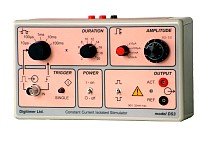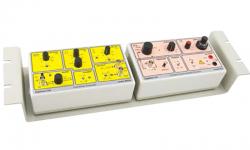Isolated Voltage (DS2A) and Isolated Current (DS3) Stimulators
Isolated stimulators with current or voltage stabilization capability (depending on model). Triggered by an external signal. Adjustment of parameters with front panel knobs. Battery powered.
- Overview
- Specifications
- Links
In biomedical research, brief electrical impulses are delivered as a stimulus to stimulate nerve or muscle fibers.
Electrically separated from the earth and outside triggers. As a result, there aren't many artifacts in the electrophysiological data that were introduced by the stimulator.
Digitimer Isolated Stimulators' Advantages Include:
- Precise and repeatable stimulation parameters.
- Changeable polarity.
- Variable stimulus intensity.
- Flexible stimulation times (20 μs to 2 s).
- Adjustment pulse input allows for external control of stimulation duration (bayonet coupler).
- A single pulse button that is unaffected by the control inputs.
- Housing constructed from an insulating substance.
- A power source using common batteries (9 V, "Krone" format). Only the stimulation pulse causes charge consumption. Battery test socket built in.
- LED stimulation signaling.
Isolating Voltage Stabilized Stimulator, DS2A-Mk.II
Depending on the tissue, different voltages may be required to generate current. Controlling the stimulus' driving force is a crucial feature of the stimulator.
- It offers two voltage ranges, the highest of which is 99V, and the lowest of which is 9V. Additionally, the stimulation strength can be set as a percentage of the maximum voltage within the chosen range using a multi-turn digital scale.A
- A rectangular pulse with an active load that has a rising duration less than 1 µs and a fall time less than 3 µs.
- In the case of currents more than 50mA, the automatic overload prevention circuit decreases the pulse width to less than 10 µs, preventing extra output current.
DS3, Isolating Stimulator, Current Stabilized
Even when considerable variations in total resistance occur throughout an experiment, it can still deliver stimulation (otherwise resulting in loss of stimulation).
- Allows for fine adjustment of the stimulation force (2 µA to 32 mA) using a multi-turn scale and a four position range selector (10 mA, 100 mA, 1 mA, 10 mA).
- Within 20 seconds after each shock, an output (latching) circuit is activated, which removes up to 1000 pF of capacitance from the cells. As the stimulation pulses are applied, it prevents capacitance buildup and stimulation loss.
- Voltage 87V at the top of each range (90V; ten 9V batteries) ("old" batteries reduce voltage from 9V to approximately 6V).
A 19" device rack may hold one or two stimulators using the frame D121-11.
You can also visit site of the manufacturer.



